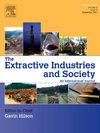Mining in the Amazon: An exploration of the tensions between infrastructure development, environmental protection, and indigenous rights under international and national laws
IF 4.3
2区 社会学
Q2 ENVIRONMENTAL STUDIES
Extractive Industries and Society-An International Journal
Pub Date : 2025-02-21
DOI:10.1016/j.exis.2025.101628
引用次数: 0
Abstract
This research examines the critical tensions between infrastructure development, environmental protection, and indigenous rights in the context of illegal mining in the Peruvian Amazon from 2008 to 2021. While infrastructure expansion is often seen as a driver of economic growth, it has simultaneously facilitated illicit mining activities, particularly within Indigenous Lands (ILs). Using Kernel Density Estimation (KDE) and binary logistic regression, this study maps the spatial distribution of illegal mining activities and identifies the primary factors driving their expansion in Peru's Amazonian region. The findings reveal a substantial increase in illegal mining over the last five years, particularly in the territories of Madre de Dios, Ucayali, and Loreto, where clandestine transportation networks, including unofficial roads and airstrips, have enabled unauthorized extractive activities. Regression analysis confirms that gold demand, proximity to clandestine infrastructure, and weak enforcement mechanisms are the leading contributors to illegal mining in Indigenous Lands. These results underscore the conflict between economic expansion and conservation efforts, exposing loopholes in legal frameworks and the marginalization of indigenous communities under Peruvian national laws and international human rights agreements. This study contributes to policy discussions on sustainable resource governance and the protection of indigenous territories in the Amazon, emphasizing the need for enhanced monitoring mechanisms, stricter enforcement policies, and participatory decision-making involving indigenous communities.
亚马逊地区的采矿:探索基础设施发展、环境保护和国际和国家法律下的土著权利之间的紧张关系
本研究考察了2008年至2021年秘鲁亚马逊地区非法采矿背景下基础设施发展、环境保护和土著权利之间的关键紧张关系。虽然基础设施扩建通常被视为经济增长的推动力,但它同时也促进了非法采矿活动,特别是在土著土地(ILs)内。本研究利用核密度估计(KDE)和二元逻辑回归,绘制了秘鲁亚马逊地区非法采矿活动的空间分布图,并确定了推动非法采矿活动扩张的主要因素。调查结果显示,在过去五年中,非法采矿大幅增加,特别是在马德雷·德迪奥斯、乌卡亚利和洛雷托地区,那里的秘密运输网络,包括非官方的道路和飞机跑道,使未经授权的开采活动成为可能。回归分析证实,黄金需求、靠近秘密基础设施以及执法机制薄弱是土著土地非法采矿的主要原因。这些结果突显了经济扩张与保护努力之间的冲突,暴露了秘鲁国家法律和国际人权协定下法律框架的漏洞和土著社区的边缘化。本研究有助于对亚马逊地区可持续资源治理和土著领土保护的政策讨论,强调需要加强监测机制、更严格的执法政策和涉及土著社区的参与性决策。
本文章由计算机程序翻译,如有差异,请以英文原文为准。
求助全文
约1分钟内获得全文
求助全文
来源期刊

Extractive Industries and Society-An International Journal
ENVIRONMENTAL STUDIES-
CiteScore
6.60
自引率
19.40%
发文量
135
 求助内容:
求助内容: 应助结果提醒方式:
应助结果提醒方式:


